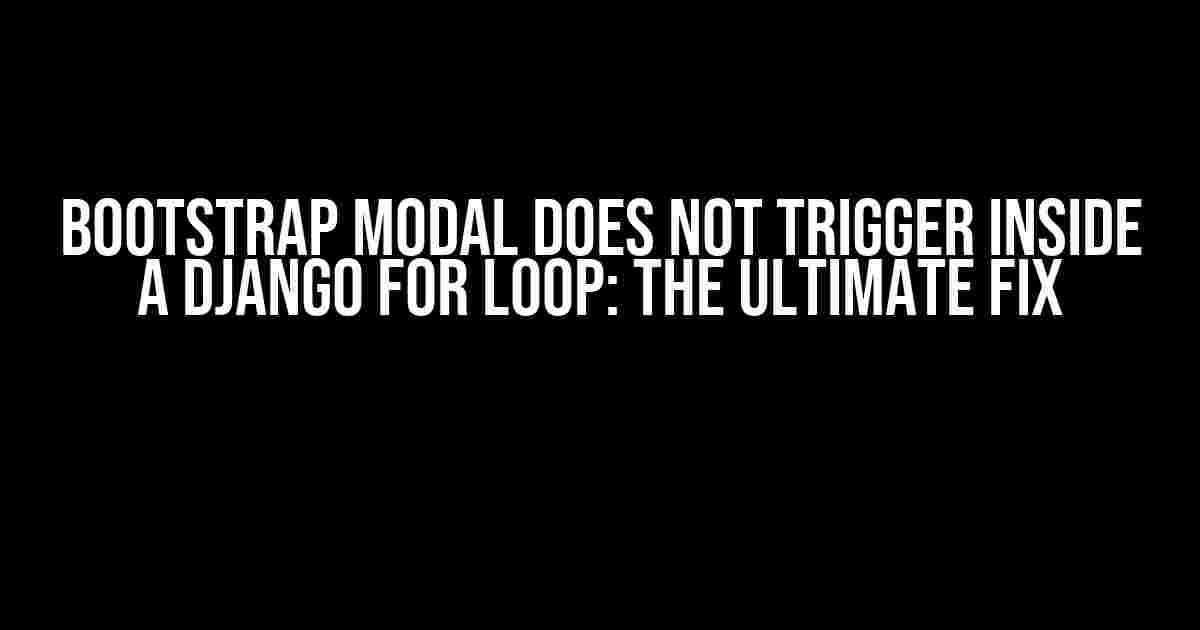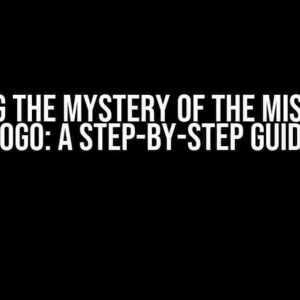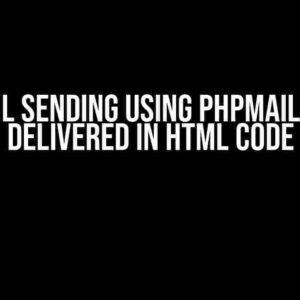Are you frustrated with your Bootstrap modal not triggering inside a Django for loop? You’re not alone! Many developers have encountered this issue, and it’s more common than you think. In this article, we’ll dive into the reasons behind this problem and provide a step-by-step guide on how to fix it. So, buckle up and let’s get started!
Understanding the Issue
The Bootstrap modal is a powerful tool for creating modal windows that can be triggered by clicking on a button or link. However, when you try to trigger a modal inside a Django for loop, it simply doesn’t work. But why is that?
Django’s Looping Magic
In Django, the for loop is used to iterate over a list of objects or values. When you use a for loop in your template, Django creates a loop context that allows you to access the loop variables. However, this context is limited to the scope of the loop, which means that any HTML elements or JavaScript code inside the loop will not be executed outside of the loop.
Bootstrap Modal’s JavaScript Magic
Bootstrap modal relies heavily on JavaScript to function. When you click on the trigger element, Bootstrap’s JavaScript code kicks in and creates the modal window. However, this code is executed outside of the Django for loop context, which means that it can’t access the loop variables or the HTML elements inside the loop.
The Solution
So, how do you fix this issue? The solution is to move the Bootstrap modal trigger outside of the Django for loop. But how do you do that? Fear not, young developer, for we have a few tricks up our sleeve!
Method 1: Use a Single Trigger Element
One way to fix this issue is to create a single trigger element outside of the Django for loop and use JavaScript to pass the loop variables to the modal. Here’s an example:
<button id="modal-trigger" data-toggle="modal" data-target="#myModal">Show Modal</button>
<div class="modal" id="myModal">
<div class="modal-dialog">
<div class="modal-content">
<div class="modal-header">
<button type="button" class="close" data-dismiss="modal">×</button>
<h4 class="modal-title">Modal Title</h4>
</div>
<div class="modal-body">
<p>Modal body content</p>
</div>
</div>
</div>
</div>
<script>
$('#modal-trigger').on('click', function() {
var loopVariable = '{{ loop_variable }}';
$('#myModal').modal('show');
$('#myModal').on('shown.bs.modal', function() {
$('#modal-body').html('Modal body content with ' + loopVariable);
});
});
</script>
In this example, we create a single trigger element outside of the Django for loop and use JavaScript to pass the loop variable to the modal. When the modal is shown, we update the modal body content using the passed variable.
Method 2: Use a Loop-Specific Trigger Element
Another way to fix this issue is to create a trigger element inside the Django for loop, but with a unique ID for each iteration. Here’s an example:
{% for item in items %}
<button id="modal-trigger-{{ forloop.counter }}" data-toggle="modal" data-target="#myModal-{{ forloop.counter }}">Show Modal</button>
<div class="modal" id="myModal-{{ forloop.counter }}">
<div class="modal-dialog">
<div class="modal-content">
<div class="modal-header">
<button type="button" class="close" data-dismiss="modal">×</button>
<h4 class="modal-title">Modal Title</h4>
</div>
<div class="modal-body">
<p>Modal body content with {{ item.name }}</p>
</div>
</div>
</div>
</div>
{% endfor %}
<script>
$('[id^="modal-trigger"]').on('click', function() {
var modalId = $(this).attr('data-target');
$(modalId).modal('show');
});
</script>
In this example, we create a trigger element inside the Django for loop with a unique ID for each iteration. We also create a unique modal element for each iteration. When the trigger element is clicked, we use JavaScript to show the corresponding modal element.
Method 3: Use a jQuery Plugin
If you’re using a lot of modals in your template, you might want to consider using a jQuery plugin to simplify the process. One popular plugin is [Bootstrap Modal](https://github.com/jschr/bootstrap-modal), which provides a simple way to create and manage modals.
<script>
$(document).ready(function() {
$('[data-toggle="modal"]').modal({
show: function(event, ui) {
var loopVariable = '{{ loop_variable }}';
$(ui.modal).find('.modal-body').html('Modal body content with ' + loopVariable);
}
});
});
</script>
In this example, we use the Bootstrap Modal plugin to create and manage our modals. We pass the loop variable to the modal using the `show` callback function.
Conclusion
In conclusion, the Bootstrap modal does not trigger inside a Django for loop due to the way Django’s loop context works. However, by using one of the methods outlined above, you can easily fix this issue and create modals that work seamlessly with your Django templates.
Troubleshooting Tips
If you’re still having trouble getting your modal to work, here are some troubleshooting tips to help you out:
- Make sure you have included the Bootstrap JavaScript and CSS files in your template.
- Check that you have added the `data-toggle` and `data-target` attributes to your trigger element.
- Verify that your modal element has a unique ID for each iteration of the loop.
- Use the browser’s developer tools to inspect the HTML elements and JavaScript code to ensure that everything is working as expected.
Common Pitfalls
When working with Bootstrap modals and Django for loops, there are some common pitfalls to avoid:
| Pitfall | Description |
|---|---|
| Not using a unique ID for each modal element | If you don’t use a unique ID for each modal element, the modal will not work correctly. |
| Not passing the loop variable to the modal | If you don’t pass the loop variable to the modal, the modal will not display the correct content. |
| Not using JavaScript to show the modal | If you don’t use JavaScript to show the modal, the modal will not work correctly. |
Frequently Asked Questions
Here are some frequently asked questions about Bootstrap modals and Django for loops:
-
Q: Why does my modal not work inside a Django for loop?
A: The Django for loop creates a loop context that limits the scope of the HTML elements and JavaScript code inside the loop. This means that the Bootstrap modal JavaScript code cannot access the loop variables or HTML elements inside the loop.
-
Q: How do I pass the loop variable to the modal?
A: You can pass the loop variable to the modal using JavaScript. You can create a unique ID for each modal element and use JavaScript to update the modal content with the loop variable.
-
Q: What is the best way to create a modal inside a Django for loop?
A: The best way to create a modal inside a Django for loop is to use a combination of HTML, JavaScript, and CSS. You can create a trigger element inside the loop and use JavaScript to show the modal. You can also use a jQuery plugin to simplify the process.
We hope this article has helped you understand why the Bootstrap modal does not trigger inside a Django for loop and provided you with the solutions to fix this issue. Remember to always
Frequently Asked Questions
Got stuck with Bootstrap modal not triggering inside a Django for loop? Worry not, friend! We’ve got you covered with the most frequently asked questions and their solutions.
Why is my Bootstrap modal not popping up inside a Django for loop?
This might be due to the modal’s ID being duplicated inside the loop. Try using a unique ID for each modal instance, or use a single modal and update its content dynamically using JavaScript.
I’ve used a unique ID for each modal, but it still doesn’t work. What’s next?
Check if the modal’s trigger element is properly linked to the modal itself. Ensure that the `data-target` attribute in the trigger element matches the modal’s ID. Also, verify that you’ve included the necessary Bootstrap JavaScript files in your Django template.
Can I use Django’s template for loop variable to generate unique modal IDs?
Yes, you can use Django’s template for loop variable to generate unique modal IDs. For example, you can use `{{ forloop.counter }}` to append a unique number to each modal’s ID. This way, each modal will have a distinct ID, and the issue should be resolved.
I’m using a complex Django template structure. Can I still use Bootstrap modal inside a for loop?
Yes, you can still use Bootstrap modal inside a for loop even with a complex Django template structure. Just ensure that you’re properly nesting your modal instances and trigger elements within the loop. You might need to use a combination of Django’s template tags and Bootstrap’s JavaScript to achieve this.
What’s the best approach to debug Bootstrap modal issues inside a Django for loop?
The best approach is to use your browser’s developer tools to inspect the HTML structure and verify that the modal instances are being generated correctly inside the loop. Check the console for any JavaScript errors, and use a debugging tool like jQuery’s `.trigger()` method to test the modal’s trigger element.





